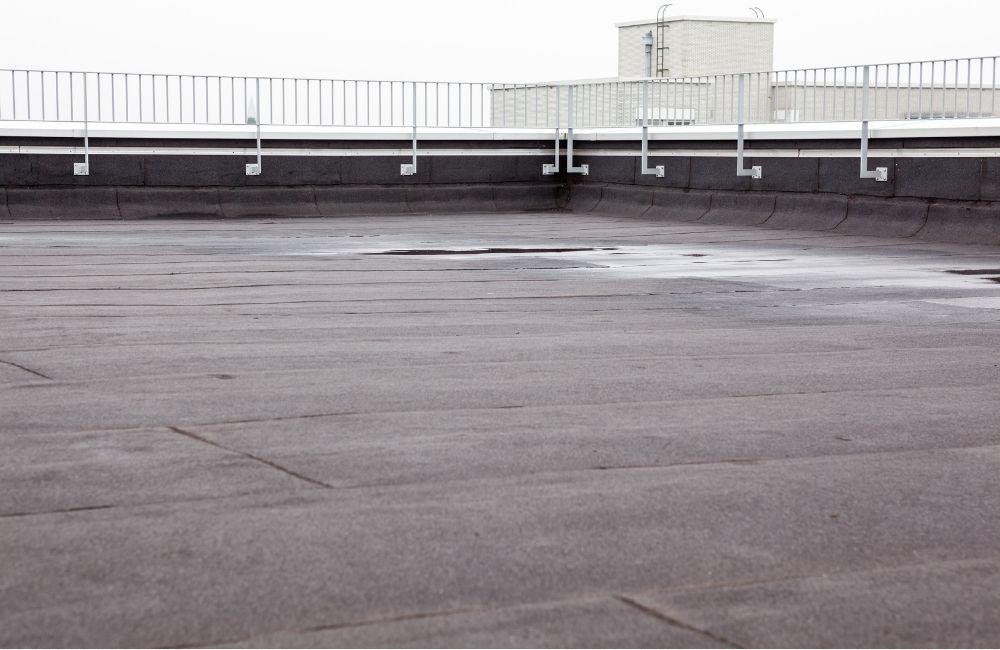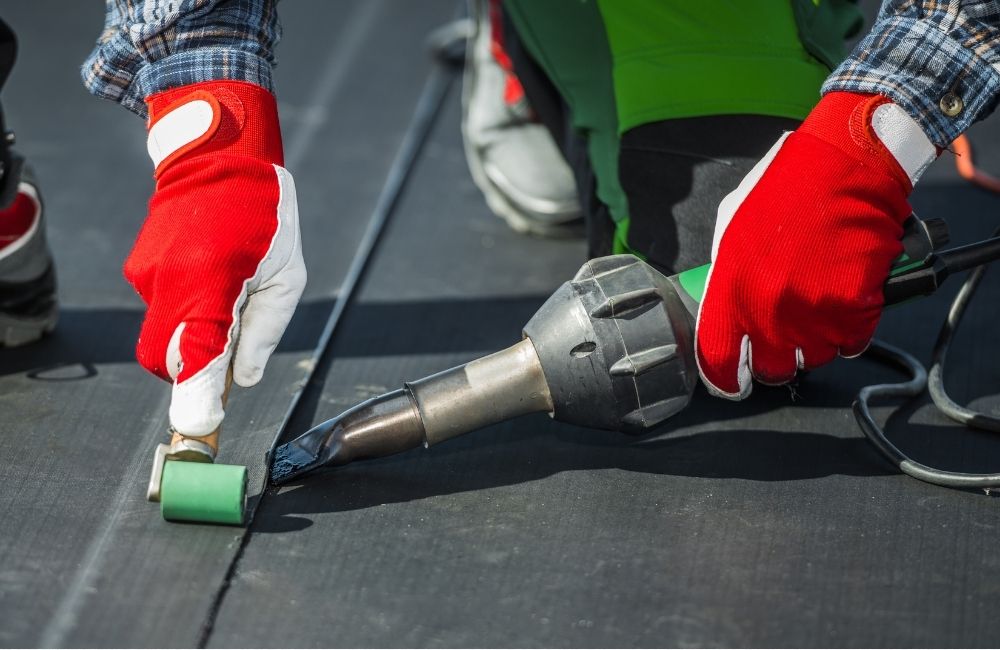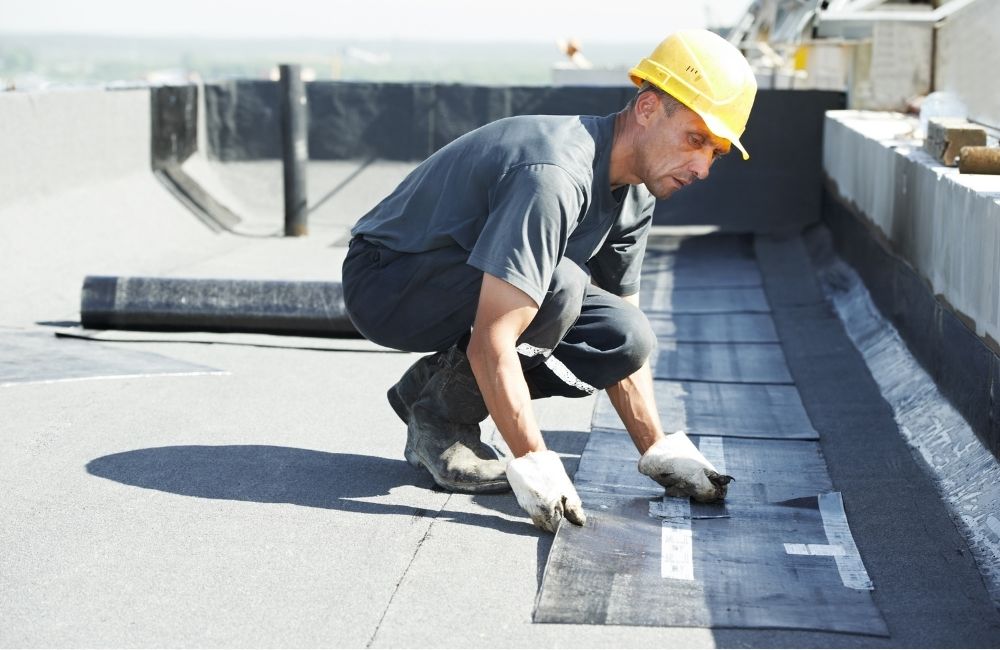- Free Estimates

✔ EPDM rubber roofing is highly durable and can last over 30 years with minimal maintenance, making it a long-term solution for commercial buildings.
✔ Its reflective properties and insulating capabilities help regulate indoor temperatures, reducing energy costs year-round.
✔ With affordable installation and low maintenance requirements, EPDM roofing systems provide excellent cost savings over time.
✔ The lightweight material and straightforward application process make installation quick, while seamless repairs extend its lifespan.
✔ Made from recyclable materials and designed for energy efficiency, EPDM rubber roofing supports sustainability efforts in commercial construction.
Choosing the right roofing material is essential for the longevity and efficiency of a commercial building. With constant exposure to harsh weather, UV rays, and potential structural stress, a durable and cost-effective solution is necessary. EPDM rubber roofing has become a preferred choice for businesses due to its exceptional durability, weather resistance, and energy efficiency.
This roofing system offers long-lasting protection, requires minimal maintenance, and provides excellent insulation, making it a smart investment for commercial properties. Whether for new construction or roof replacement, EPDM delivers reliable performance in various climates and conditions.
Here are the key reasons why EPDM rubber roofing stands out as the best choice for commercial buildings.
EPDM rubber is widely recognized for its exceptional durability and long lifespan, making it a reliable choice for commercial roofing. It is designed to withstand extreme weather conditions while requiring minimal maintenance, ensuring long-term performance.
EPDM rubber is widely recognized for its exceptional durability and long lifespan, making it a reliable choice for commercial roofing. It is designed to withstand extreme weather conditions while requiring minimal maintenance, ensuring long-term performance.
EPDM rubber sheets are engineered for longevity, providing decades of reliable protection with little upkeep required.
One of the key advantages of EPDM rubber roofing is its ability to prevent leaks and water-related damage.
EPDM roofing systems offer outstanding energy efficiency, making them a preferred choice for commercial buildings. With their ability to reflect heat and provide insulation, these roofing solutions contribute to lower energy costs and a more comfortable indoor environment.
One of the key benefits of EPDM rubber roofing is its ability to regulate indoor temperatures by reflecting heat. This feature helps in maintaining a cooler interior, especially in warm climates.
EPDM rubber roofing does more than just reflect heat; it also provides insulation, which helps in maintaining stable indoor temperatures throughout the year.
EPDM rubber is a highly cost-effective solution for commercial roofing due to its affordability and long-term financial benefits. It offers a balance between initial investment and long-term durability, making it a practical choice for businesses looking for a reliable roofing system.
EPDM roofing systems provide a budget-friendly option compared to other commercial roofing materials. The cost-effectiveness comes from both the lower material costs and the efficiency of the installation process.
One of the key advantages of EPDM rubber is its low maintenance requirements. The material is designed to withstand harsh environmental conditions, reducing the need for frequent repairs and replacements.

EPDM rubber roofing systems are known for their straightforward installation process and hassle-free maintenance. Commercial building owners and contractors prefer this material because of its efficiency in both installation and repairs. Its flexibility and durability ensure long-term performance while minimizing downtime for businesses.
EPDM roofing systems offer a streamlined installation process, making them a practical choice for commercial buildings. The lightweight nature of EPDM rubber sheets reduces labor costs and speeds up the installation process.
One of the biggest advantages of EPDM rubber is its ability to withstand damage and allow for simple repairs. When properly maintained, these roofs can last over 30 years with minimal upkeep.
EPDM rubber is not only a durable and cost-effective roofing material but also an environmentally friendly choice for commercial buildings. With a focus on sustainability, energy efficiency, and waste reduction, EPDM roofing systems help businesses reduce their environmental impact while maintaining superior performance.
EPDM rubber is produced using materials that can be repurposed or recycled, making it a sustainable roofing option that minimizes waste and supports eco-conscious building practices.
EPDM roofing systems provide excellent waterproofing, which helps with water conservation efforts in commercial properties.
EPDM rubber helps commercial buildings lower their energy consumption by providing natural insulation and heat reflection, leading to reduced carbon emissions and lower utility costs.
Choosing EPDM rubber for commercial roofing contributes to broader sustainable building efforts that align with environmental certifications and green construction standards.
Selecting the right roofing provider is crucial when installing EPDM rubber roofing for a commercial property. A high-quality installation ensures long-lasting durability, energy efficiency, and superior weather resistance. To make an informed decision, consider these key factors when choosing a roofing provider.
Not all roofing contractors specialize in EPDM roofing systems. It’s important to choose a provider with proven experience in handling EPDM rubber sheets, membranes, and installation techniques. An experienced contractor understands the material’s flexibility, application methods, and how to ensure a seamless, watertight finish that maximizes longevity.
A reputable roofing provider should have the necessary licenses and certifications required in your area. Proper licensing ensures they meet industry standards, while insurance coverage protects against potential accidents or damages during the installation process. Verifying these credentials can prevent liability issues and ensure compliance with local building codes.
Looking at past projects can provide insight into a contractor’s workmanship. Check for customer reviews, testimonials, or case studies showcasing EPDM rubber roofing installations. A provider with a track record of successful projects and satisfied clients is more likely to deliver quality results.
The performance of an EPDM roofing system depends not only on expert installation but also on the quality of materials used. Ensure the provider sources premium EPDM rubber sheets and membranes that are resistant to UV rays, weathering, and chemical exposure. Low-quality materials can lead to premature wear and costly repairs.
A reliable roofing provider should offer a transparent and detailed estimate that outlines material costs, labor, and project timelines. Additionally, inquire about warranty coverage on both materials and workmanship. A strong warranty indicates confidence in the durability of the installation and provides peace of mind in case of future issues.
Effective communication is essential throughout the roofing project. Choose a provider that is responsive, willing to answer questions, and provides regular updates. A contractor who prioritizes customer service ensures a smooth installation process and addresses concerns promptly.
In some cases, EPDM can be installed over an existing roof, but it depends on the condition of the old roofing material. The surface must be clean, dry, and structurally sound before installation. If the old roof has severe damage, leaks, or mold, it may need to be removed first. Installing EPDM over an old roof can save time and labor costs. However, a professional inspection is necessary to determine if this approach is suitable.
EPDM roofing is primarily available in black and white. Black EPDM absorbs heat, making it suitable for colder climates, while white EPDM reflects heat, helping keep buildings cooler. The white version is often used in areas with high temperatures to improve energy efficiency. Some coatings can be applied to change the color or enhance reflectivity. However, EPDM is not typically available in a wide range of colors like other roofing materials. Most commercial buildings stick to black or white for practical and cost-effective reasons.
EPDM roofing requires minimal maintenance compared to other roofing types. Regular inspections, especially after storms or harsh weather, help detect any issues early. Cleaning the roof occasionally can prevent debris buildup and potential water pooling. If small cracks or punctures appear, they should be repaired quickly to prevent further damage. Keeping drains and gutters clear also helps maintain the roof’s condition.
EPDM roofing can be repaired if it gets damaged. Small leaks or tears can often be fixed using a patch or special adhesive. Unlike some other roofing materials, EPDM does not require complete replacement for minor issues. Regular inspections help identify damage early, making repairs easier and less expensive. If a large section is damaged, professionals can replace just that portion instead of the entire roof.
EPDM roofing is best suited for commercial buildings with flat or low-slope roofs. It may not be the best choice for buildings with steep-sloped roofs, as it is designed to be applied in large sheets. Many warehouses, shopping centers, office buildings, and industrial facilities use EPDM because of its practicality. It can also be installed on smaller buildings like restaurants or storage units. If a building already has another type of roofing, EPDM can sometimes be installed over it. However, a professional inspection is necessary to determine if this is a good option.

Ensure your building stays secure with high-quality EPDM roofing solutions from your local Roofing Company in West Hartford, CT. As trusted roofers near you, we specialize in installing durable, weather-resistant roofing systems that stand up to the toughest conditions. From preventing leaks to withstanding heavy storms, our team delivers reliable, long-lasting protection for commercial properties across Connecticut.
Contact the best Roofing Company in West Hartford, CT today to get expert EPDM roofing services tailored to your needs!